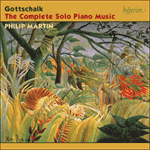
Welcome to Hyperion Records, a British classical label devoted to presenting high-quality recordings of music of all styles and from all periods from the twelfth century to the twenty-first.
Hyperion offers both CDs, and downloads in a number of formats. The site is also available in several languages.
Please use the dropdown buttons to set your preferred options, or use the checkbox to accept the defaults.

It was during this sojourn that he managed somehow to get round to writing down several earlier compositions, of which Bataille is one. Its tranquil opening theme (E flat major) is reminiscent of a Stephen Foster ballad (on its final return, Gottschalk offers a decorative ossia) leading to an ardito (‘bold’) galop. Gottschalk on auto-pilot it may be, but the final pages are demanding enough with the composer’s trademark huge rhythmic leaps in the left hand and the right hand way above the stave. (Not to be confused with the earlier La Bataille de Carabovo [1859, but now lost] intended as a victory march for Gottschalk’s friend the Venezuelan General Páez, ‘thrice liberator of the Spanish Americas’.)
from notes by Jeremy Nicholas © 2001
C’est pendant ce séjour qu’il parvint toutefois à composer de nombreuses de ses premières compositions dont Bataille. Son thème d’ouverture tranquille (mi bémol majeur) rappelle une ballade de Stephen Foster (au retour final du thème, Gottschalk offre un ossia décoratif) et mène à un galop ardito (hardi). Gottschalk est peut-être sur pilote automatique, mais les pages finales n’en sont pas moins très exigeantes et sont caractéristiques des énormes écarts rythmiques du compositeur à la main gauche et des notes totalement hors portée de la main droite. (À ne pas confondre avec La Bataille de Carabovo composée précédemment, en 1859, mais désormais perdue, qui était une marche victorieuse en l’honneur de l’ami de Gottschalk, le général vénézuélien Páez, «trois fois libérateur des Amériques espagnoles».)
extrait des notes rédigées par Jeremy Nicholas © 2001
Français: Marie Luccheta
Während dieses Aufenthalts schaffte er es irgendwie, mehrere frühere Kompositionen niederzuschreiben; Bataille ist eine davon. Ihr ruhiges Eröffnungsthema (Es-Dur) erinnert an eine Ballade von Stephen Foster (beim letzten Auftreten dieses Themas bietet Gottschalk eine Ossia mit Verzierungen an) und leitet über in einen ardito („kühn“) bezeichneten Galopp. Gottschalk mag mit den Gedanken woanders gewesen sein, doch die Schlußseiten sind auf Grund der für den Komponisten typischen gewaltigen rhythmischen Sprünge in der linken Hand, während die rechte hoch über dem Notensystem spielt, schwierig genug. (Dieses Stück darf nicht mit dem noch früher entstandenen La Bataille de Carabovo [1859, seither verschollen] verwechselt werden, das als Siegesmarsch für Gottschalks Freund, den venezolanischen General Páez gedacht war, den „dreifachen Befreier Hispanoamerikas“.)
aus dem Begleittext von Jeremy Nicholas © 2001
Deutsch: Anne Steeb/Bernd Müller
 Gottschalk: The Complete Solo Piano Music Gottschalk: The Complete Solo Piano MusicWith his idiomatic and graceful style, pianist Philip Martin has established himself as the foremost exponent of Gottschalk. The composer had a unique spontaneity and individuality which Martin’s performances bring vividly to the fore. The complet ...» More |

